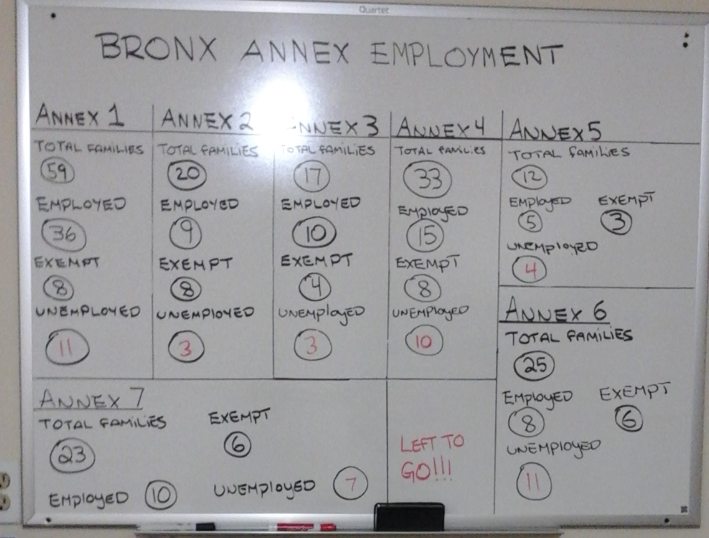Bridge to Employment
By Julian Velez
Jorge Diaz, 22, is currently unemployed and lives in a Bronx shelter with his girlfriend, Crystal Merejildo, and their young daughter. Diaz lived in Connecticut for most of his life. However, he was forced to leave after losing his two warehouse jobs and being evicted from his apartment. With a family to feed, Diaz turned to his relatives for help, but they didn’t welcome him with open doors. “A lot of my family, that I thought were family, didn’t want to help me,” said Diaz.
Luckily, Merejildo’s mother, from the Bronx, agreed to house the family. Unfortunately, that luck ran out a month later. The apartment building Diaz and his family were staying at was in violation of code and all tenants living there were evacuated. Diaz and his family had no other choice but to seek refuge at a shelter where they’ve been struggling to find sustainable employment for over six months.
Diaz isn’t the only one affected by unemployment and the decline in the economy. The Bronx is home to the highest unemployment rate in New York. In April 2015, the unemployment rate of the Bronx was 8.3 percent compared the national average of only 5.5 percent. As of August 2015, the unemployment rate in the Bronx dropped to 7.3 percent; however, the rate is still high compared that of New York City’s average, 5.4 percent, and New York State’s average, 5.2 percent.

The number of families living in shelters under Housing Bridge.
According to the U.S Census, from 2009-2013 almost 30 percent of Bronxites lived below the poverty line. The Bronx also has the greatest concentration of public housing compared to the other boroughs. For over 10 years, the Bronx has remained the poorest borough in New York City and one of the poorest areas in New York State.
There is room for debate about the reasons why the unemployment and poverty rate in the Bronx are so high compared to other areas. A common belief is that many Bronxites are lazy and choose to abuse the welfare system.
“I’ve seen it so many times,” said Timothy Zayas, a paralegal at Chartwell Law Offices, “people start getting their unemployment or welfare checks and they get used to it. They get complacent and decide to stay where they’re at instead of striving to improve themselves. It’s the same with people that get used to working at a low paying job, they get accustomed to it and sometimes they lose the motivation to advance their career.”
Haywood Cepeda, an employment manager at Housing Bridge, an organization that helps move needy families into permanent housing, says that unemployment is much more complicated. “It’s really complex and intricate,” says Cepeda. “Social, economic, and educational factors play a role in the unemployment crisis. Everything is knotted together.”

Cepeda explains that a lot of high schools in the Bronx and all over New York City are shifting their focus to standardized tests and exams rather than teaching content that inspires students to learn and further their education. In 2014, the Bronx had a high school dropout rate of 14.1 percent, the highest in New York City.
The rising cost of higher education is also to blame. “In order to have money, you need a good job,” says Cepeda. “In order to have a good job, you need an education and skill set. In order to pay for an education, you need money. A lot of students in the Bronx have to balance school, a part-time, family obligations, and a social life.” People that do manage to graduate from college and beyond often struggle to find a good starting position, graduation doesn’t always guarantee a career, he says.
Another issue is drug use and criminal history. “Certain jobs require a drug test which not everyone is able to pass,” says Cepeda. “It’s hard for people with criminal backgrounds to get a solid career going because not a lot of places are willing to hire them.”
On top of it all, not everyone knows how to put together a resume or cover letter. “Some of my clients have never had a job or been to an interview,” says Cepeda. “We put together a resume from scratch and remind them to really sell their skill set and work ethic.”
Cepeda disagrees with those who say there is limited opportunity in the Bronx. “I think that the Bronx has gems and opportunities waiting to be found,” he says.
Even though the Bronx has a high unemployment and poverty rate, there are assistance programs that can help put families on the path to financial stability. Housing Bridge provides social services and has shelters all over New York.

Housing Bridge is partnered with Bridge to Employment, which helps the unemployed by providing help with resumes, offering interview coaching, and conducting skill set evaluations. There are also employment specialists that are partnered with employment agencies and training programs that offer a wide selections of jobs and preparations. Sometimes people get nervous right before a job interview and decide to bail out, the employment specialists at Bridge to Employment call to make sure their clients make it to their interviews.
Diaz and his family currently use the services provided by Housing Bridge and Bridge to Employment to try and emerge from their current crisis. Diaz met with Cepeda and was able to schedule immediate job interviews for different janitor and cleaning positions.
“These interviews are pretty early in the morning,” said Cepeda, “can you make it to them on time?”
“Yes, definitely,” said Diaz, “I’m eager to start working right away.”
